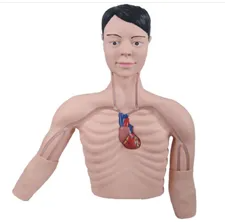Welcome to visitShanghai Chinon medical Model & Equipment Manufacturing Co., LTD
PICC (Peripheral catheterization Central venous catheterization) is an important technique widely used in modern clinical treatment, especially in patients requiring long-term intravenous infusion, drug therapy or hemodialysis. Although PICC catheterization is seemingly simple, the maximum accuracy and technical skill required in the operation process are extremely high, so theoretical learning alone is far from enough. The introduction of the PICC interventional training model provides a simulated operating environment for physicians and healthcare personnel, allowing them to practice before the actual operation, ensuring that the catheterization can be completed efficiently and safely in the clinic.
1. Clinical significance: The critical importance of precision operation for patients

PICC interventional training model
Although PICC catheterization is a common procedure, if not skilled, it can lead to some serious complications, such as failed puncture, pneumothorax, catheter displacement, and even perforation of blood vessels. These complications not only increase the pain of the patient, but can also prolong the hospital stay and even be life-threatening. Therefore, doctors must be fully trained before the actual operation to ensure that the mastery of PICC technology reaches an accurate level.
- Reduced complications : Through simulation training, medical staff can master the correct puncture technique and reduce the risk of failed vascular puncture or inaccurate catheter position.
- Improved success rate : Studies have shown that PICC catheterization success rates in practice are approximately 20% higher for health care workers trained in simulation models than for untrained physicians.
2. Industry expert opinion: The need for model training
Dr. Sarah Lee, a senior interventional physician, pointed out: "PICC catheterization seems simple, but once there is a problem in the operation, it may lead to a series of complications and even affect the life safety of patients. Although theoretical learning can help to understand the procedure, practical practice requires the physician to have the most accurate hand-eye coordination and the most profound understanding of anatomy . This is where PICC comes in and trains the model to play a key role."
Simulation training can provide real operating situations to help medical staff practice in a risk-free environment and gradually improve their operating skills. For example, models can simulate a patient's different anatomy, helping doctors quickly make adaptive adjustments when facing patients with different body types and pathologies.
3. Data support: Model training improves clinical performance
According to a study published in the Journal of Interventional Radiology, the accuracy and efficiency of the PICC interventional training model were significantly improved in practice. The study found that simulation-trained health care workers were 30% better at PICC catheterization accuracy and fluency than the non-trained group. At the same time, the use of model training can also effectively reduce the patient's operating discomfort and recovery time.
- Operational accuracy : Medical staff trained with the model increased the success rate by 25% on the first PICC placement.
- Reduced complications : Simulation training helped improve the doctor's ability to avoid common complications during the catheter placement process, especially the incidence of pneumothorax, vascular puncture errors and other problems decreased by 15%.
4. Application in clinical training: Simulation to improve medical staff skills
In clinical training, PICC interventional training model provides a repeatable and risk-free training platform for medical staff. By practicing on the model many times, the doctor is able to:
- Familiar with the operation process, master the piercing skills, and ensure that every step is accurate.
- Practice coping with various possible complications, making quick decisions and taking appropriate actions.
- Understand how to adjust the procedure according to the patient's body type and anatomical characteristics to improve the adaptability and flexibility of the procedure.
Conclusion: The importance of model simulation training
In short, PICC intervention technology training not only needs the support of theoretical learning, but also needs the assistance of the best simulation model training. Through simulation training, medical personnel can accumulate operational experience in advance, reduce clinical risks, and improve treatment effects. With the advancement of medical technology and the improvement of patient safety awareness , PICC intervention training model will become an indispensable tool in clinical medical training to help medical staff carry out PICC catheterization therapy more accurately and efficiently in actual operation to ensure the health and safety of patients.